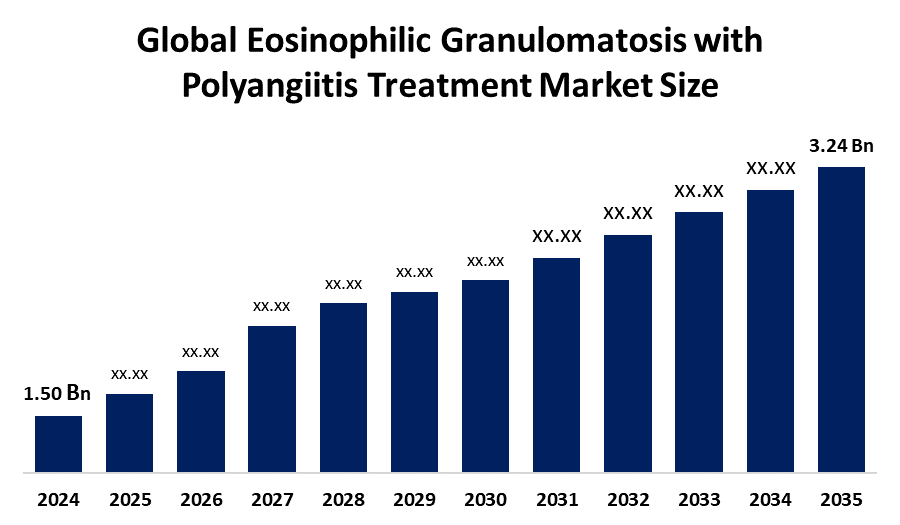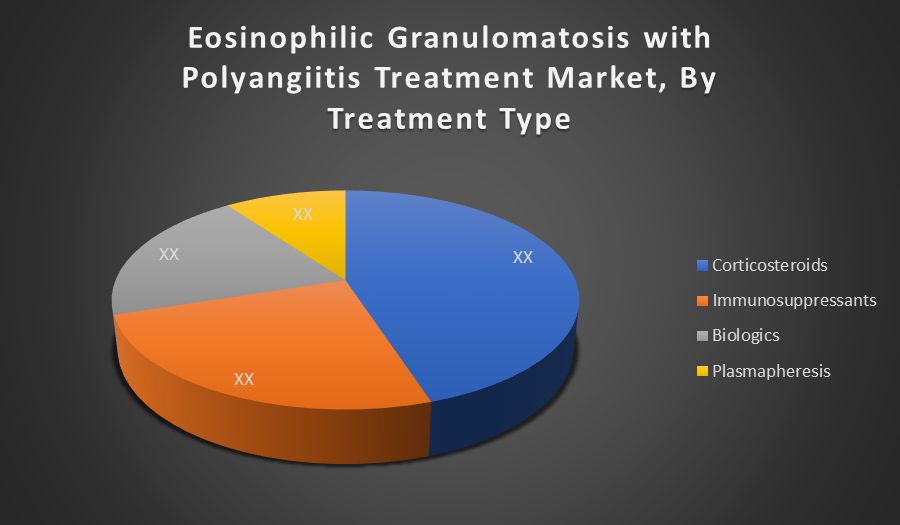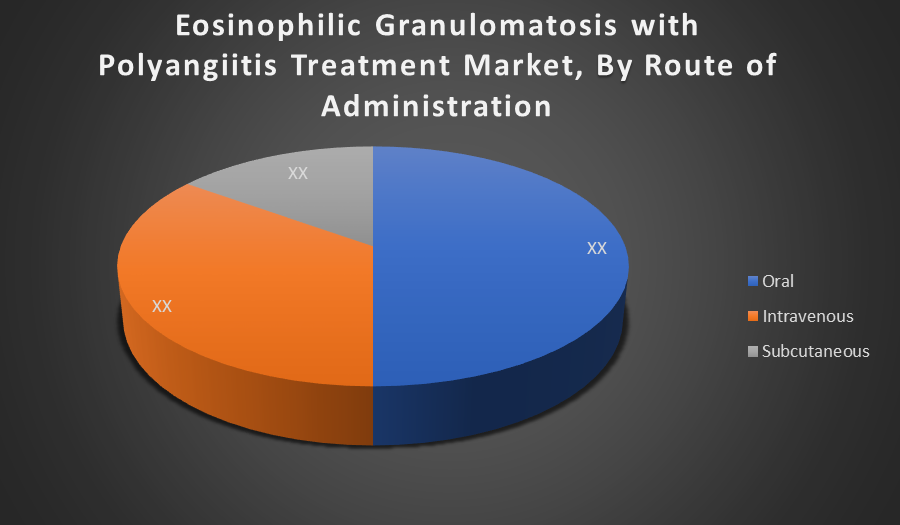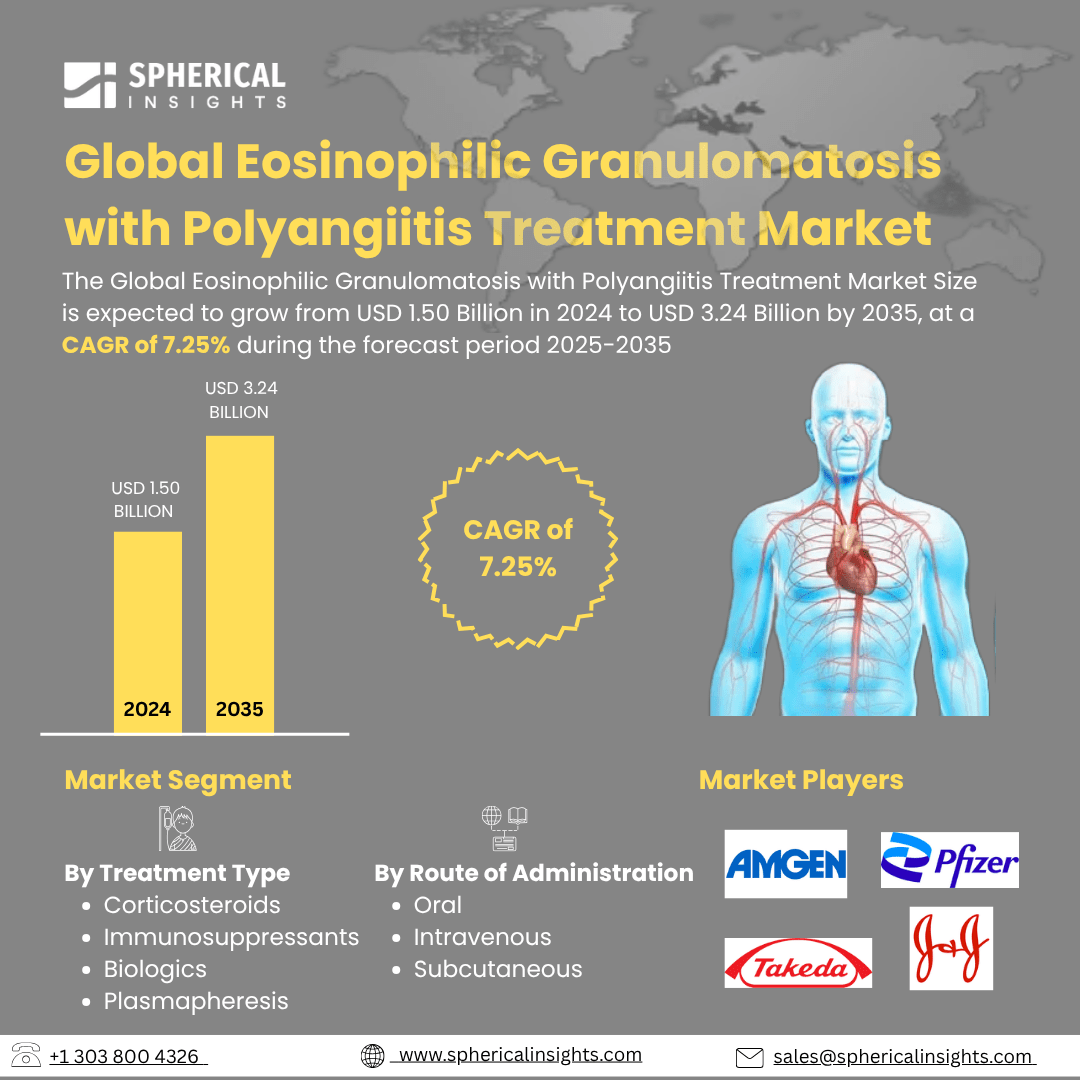- As per Spherical Insights & Consulting, The Global Eosinophilic Granulomatosis with Polyangiitis Treatment Market Size is expected to grow from USD 1.50 Billion in 2024 to USD 3.24 Billion by 2035, at a CAGR of 7.25% during the forecast period 2025-2035, owing to the launch of new therapies in the market and the rise in the number of cases.
- The leading Eosinophilic Granulomatosis with Polyangiitis Treatment Market Companies such as Amgen, Pfizer, Takeda, Johnson & Johnson, Regeneron, Teva Pharmaceuticals, Novartis, Roche, GlaxoSmithKline, Mylan, Sanofi, AstraZeneca, AbbVie, Merck & Co., Bristol Myers Squibb, and Others.

Eosinophilic Granulomatosis with Polyangiitis Treatment Market: Understanding and Treatment Algorithm:
Eosinophilic granulomatosis with polyalgitis (EGPA) is a rare autoimmune disease that causes inflammation of blood vessels and high levels of eosinophils, a type of white blood cell. It can affect lungs, skin, veins and other organs, which can cause symptoms such as asthma, fatigue, rashes, and nerve pain.
Eosinophilic Granulomatosis with Polyangiitis Diagnosis:
Diagnosing EGPA includes a combination of blood tests, imaging and tissue biopsy. Doctors seek high eosinophil count, organ damage signs and specific inflammatory patterns. Symptoms are often overlap with asthma or allergies, so early, accurate diagnosis is important to prevent long term damage and guide proper treatment.
Eosinophilic Granulomatosis with Polyangiitis Treatment:
EGPA treatment usually begins with corticosteroids to quickly control inflammation. In more severe or relapsing cases, immunosuppressants or biological drugs such as mapolizumab are added. The goal is to reduce symptoms, prevent provocative, and to reduce long term losses, managing side effects and maintaining the quality of life.
Eosinophilic Granulomatosis with Polyangiitis Treatment Epidemiology:
The disease epidemiology covered in the report provides historical as well as forecasted epidemiology segmented by Total Diagnosed Incident Population of Eosinophilic Granulomatosis with Polyangiitis Treatment, Gender specific Diagnosed Incidence of Eosinophilic Granulomatosis with Polyangiitis Treatment, Type specific Diagnosed Incidence of Eosinophilic Granulomatosis with Polyangiitis Treatment, Age specific Diagnosed Incidence of Eosinophilic Granulomatosis with Polyangiitis Treatment, Diagnosed Incident Population based on Primary Site of Eosinophilic Granulomatosis with Polyangiitis Treatment, and Diagnosed Incident Population based on Histologic Classification of Eosinophilic Granulomatosis with Polyangiitis Treatment Tumour in the global market covering North America, Europe, Asia-Pacific, Latin America, the Middle East, and Africa from 2024 to 2035.
Principal Insights:
This section offers a global overview of eosinophilic granulomatosis with polyangiitis treatment epidemiology in major markets worldwide.
Country Wise Eosinophilic Granulomatosis with Polyangiitis Treatment Multiforme Epidemiology:
- The epidemiology segment provides Eosinophilic Granulomatosis with Polyangiitis Treatment prevalence data and findings across key regions worldwide, including North America, Europe (Germany, France, Italy, Spain, and the United Kingdom), Asia-Pacific (including Japan), Latin America, the Middle East, and Africa.
Eosinophilic Granulomatosis with Polyangiitis Treatment Recent Developments:
- In November 2021, GlaxoSmithKline (GSK) plc announced that the European Commission had approved Nucala (mepolizumab), a monoclonal antibody targeting interleukin 5 (IL-5), for use in three additional eosinophil driven diseases. This authorization followed positive opinions recommended by the Committee for Medicinal Products for Human Use and authorized mepolizumab as an add on treatment for hypereosinophilic syndrome (HES), eosinophilic granulomatosis with polyangiitis (EGPA), and chronic rhinosinusitis with nasal polyps (CRSwNP).
Eosinophilic Granulomatosis with Polyangiitis Treatment Marketed Drugs:
• Nucala: GlaxoSmithKline
Nucala (mepolizumab) is an anti-IL-5 monoclonal antibody approved by the FDA for the treatment of EGPA. It works by targeting interleukin-5 to reduce eosinophil levels, helping to control inflammation and lower relapse risk. Nucala is used as an add on maintenance therapy for patients with active disease.
• Prednisone: Multiple Manufacturers
Prednisone is a corticosteroid commonly prescribed to manage inflammation and suppress the immune response in EGPA patients. It helps control acute flare ups and is often used as a first line treatment. While effective, long-term use requires monitoring due to potential side effects like weight gain and bone loss.
Eosinophilic Granulomatosis with Polyangiitis Treatment: Emerging Therapies:
- AKL-101: AKL-101 is an investigational oral SYK inhibitor being studied for EGPA. It works by targeting spleen tyrosine kinase, a key player in immune signaling and inflammation. Early trials suggest it may reduce eosinophil driven tissue damage and offer a steroid-sparing option for patients with relapsing or refractory EGPA.
- Tezepelumab: Tezepelumab is a monoclonal antibody targeting thymic stromal lymphopoietin (TSLP), currently under investigation for EGPA. By blocking TSLP, it may reduce eosinophilic inflammation and asthma related symptoms. It offers a potential new pathway for treating EGPA patients with uncontrolled respiratory involvement.
Eosinophilic Granulomatosis with Polyangiitis Treatment Market Outlook:
- EGPA treatment market includes treatment aimed at managing eosinophilic granulomatosis with polyengitis, which is a rare autoimmune disease affecting blood vessels and organs. The market contains corticosteroids, immunosuppressants, and biologics, which are distributed through various routes to control inflammation, eosinophil activity and systemic vasculitis symptoms.
- Awareness increased about rare autoimmune diseases, better clinical techniques and availability of targeted biologics drive market development. Rising clinical research activities and better healthcare access also contribute to, as well as with extended signals for drugs such as mepolizumb, which offer more treatment options for EGPA patients.
- Rare disease drug increases in development, increasing use of biologics, and progress in accurate medicine creates important opportunities. Expanding clinical trials and emerging treatments, targets eosinophil-driven inflammation for innovation, especially in areas with low diagnosis and treatment rates.
- Governments and health organizations are rare disease research, early diagnostic programs and support patient registries. Regulatory agencies also approve rapid track for orphan drugs and biology, encouraging pharmaceutical companies to invest in EGPA treatment solutions.
- Delayed diagnosis and limited awareness timely treatment and access to advanced treatments.
- The market is expected to increase continuously due to increasing prevalence, increased biologic adoption and widespread access to special care.
Eosinophilic Granulomatosis with Polyangiitis Treatment Market Segmentation:
By Treatment Type:
- Corticosteroids
- Immunosuppressants
- Biologics
- Plasmapheresis

Corticosteroids have the largest market share as the first line treatment for EGPA. They provide rapid, effective symptoms control by reducing inflammation and eosinophil levels. Widely available and cost effective, they remain the backbone of EGPA management, especially in new diagnosed cases or during acute disease.
By Route of Administration:
- Oral
- Intravenous
- Subcutaneous

The Oral administration dominates the market due to its convenience, patient compliance and comprehensive use, especially with corticosteroids such as prednisone. Oral remedies are usually used for long-term management, allowing patients to allow self-appreciating drug at home, reducing the need for hospital visits and improves overall treatment access.
Regional Segment Analysis of the Eosinophilic Granulomatosis with Polyangiitis Treatment Market:
North America holds the largest share of the EGPA treatment market due to its advanced healthcare infrastructure, high diagnosis rates, and widespread access to both standard and biologic therapies. The region benefits from strong awareness among healthcare professionals, supportive reimbursement policies, and the early adoption of FDA approved biologics, making it a dominant force in driving treatment innovation and patient access.
Asia Pacific is emerging as the fastest growing region in the EGPA treatment market, driven by improving healthcare access, rising disease awareness, and increasing investment in rare disease diagnostics. Governments and private sectors are working to enhance specialty care and early diagnosis, while growing demand for biologics and expanding clinical trial activities contribute to the region’s rapid market growth potential.
Eosinophilic Granulomatosis with Polyangiitis Treatment Market Key Companies:
- Amgen
- Pfizer
- Takeda
- Johnson & Johnson
- Regeneron
- Teva Pharmaceuticals
- Novartis
- Roche
- GlaxoSmithKline
- Mylan
- Sanofi
- AstraZeneca
- AbbVie
- Merck & Co.
- Bristol Myers Squibb
- Others
Eosinophilic Granulomatosis with Polyangiitis Treatment Therapeutics Market Report Scope:
- The Eosinophilic Granulomatosis with Polyangiitis Treatment therapeutics market report provides a detailed overview, covering its causes, symptoms, disease progression, and existing treatment options.
- Detailed insights into Eosinophilic Granulomatosis with Polyangiitis Treatment’s epidemiology and therapeutic approaches are included.
- Additionally, a comprehensive review of existing and emerging Eosinophilic Granulomatosis with Polyangiitis Treatment therapies is provided, including an evaluation of new treatments expected to influence the current Eosinophilic Granulomatosis with Polyangiitis Treatment market landscape.
- The report includes a detailed review of the Eosinophilic Granulomatosis with Polyangiitis Treatment therapeutics market, both historical and forecasted, highlighting the global drug reach.
- The Patient-Based Eosinophilic Granulomatosis with Polyangiitis Treatment Market Forecasting report offers valuable insights into trends shaping the global Eosinophilic Granulomatosis with Polyangiitis Treatment market, helping to develop effective business strategies.
Eosinophilic Granulomatosis with Polyangiitis Treatment Market Report Insights:
- Forecasting Market Trends Based on Patient Data and Disease Rates
- Eosinophilic Granulomatosis with Polyangiitis Treatment Therapeutic Approaches in Eosinophilic Granulomatosis with Polyangiitis Treatment
- Review Of Drugs in Development for Eosinophilic Granulomatosis with Polyangiitis Treatment
- Market, Growth, and Trends in Eosinophilic Granulomatosis with Polyangiitis Treatment
- Market Opportunities in Eosinophilic Granulomatosis with Polyangiitis Treatment
- Effects Of Future Therapies on Eosinophilic Granulomatosis with Polyangiitis Treatment
Eosinophilic Granulomatosis with Polyangiitis Treatment Market Report Key Strengths
- 15 Years Eosinophilic Granulomatosis with Polyangiitis Treatment Market Forecast
- Global Coverage
- Eosinophilic Granulomatosis with Polyangiitis Treatment Epidemiology Segmentation
- Key Cross Competition
Eosinophilic Granulomatosis with Polyangiitis Treatment Market Report Assessment
- Present Practices in the Eosinophilic Granulomatosis with Polyangiitis Treatment Market
- Review of Investigational Eosinophilic Granulomatosis with Polyangiitis Treatment Drugs
- Attractiveness of the Eosinophilic Granulomatosis with Polyangiitis Treatment Drug Market
- Eosinophilic Granulomatosis with Polyangiitis Treatment Market Drivers
- Eosinophilic Granulomatosis with Polyangiitis Treatment Market Barriers
- SWOT
- Attribute Analysis
Market Segment:
This study forecasts revenue at the global, regional, and country levels from 2020 to 2035. Spherical Insights has segmented the eosinophilic granulomatosis with polyangiitis treatment market based on the below-mentioned segments:
Global Eosinophilic Granulomatosis with Polyangiitis Treatment Market, By Treatment Type
- Corticosteroids
- Immunosuppressants
- Biologics
- Plasmapheresis
Global Eosinophilic Granulomatosis with Polyangiitis Treatment Market, By Route of Administration
- Oral
- Intravenous
- Subcutaneous
Global Eosinophilic Granulomatosis with Polyangiitis Treatment Market, By Regional Analysis
- North America
- Europe
- Germany
- UK
- France
- Italy
- Spain
- Russia
- Rest of Europe
- Asia Pacific
- China
- Japan
- India
- South Korea
- Australia
- Rest of Asia Pacific
- South America
- Brazil
- Argentina
- Rest of South America
- Middle East & Africa
- UAE
- Saudi Arabia
- Qatar
- South Africa
- Rest of the Middle East & Africa






